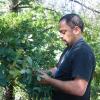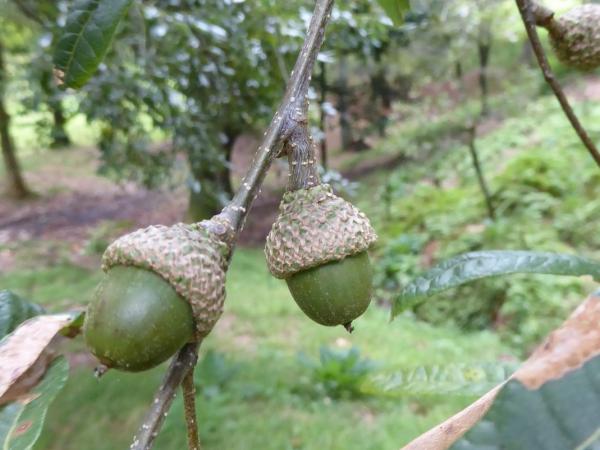Editor's Picks
Plant Focus
Species Spotlight: Quercus ilicifolia Wangenh.
Quercus ilicifolia is a little oak with a big name: bear oak. With such a powerful-sounding name one might expect a towering giant of a tree with thick branches and large acorns. However, bear oak is not an impressive behemoth but a gnarled, branching shrub. Furthermore, this oak is not a stalwart, long-lived survivor and seems quite persnickety in its choice of habitat. Nevertheless, it is an intriguing species.

Q. ilicifolia is a small tree, or shrub, that can reach 1-8 m in height with branches 5-12 cm wide. Its name, which derives from Ilex (holly) and folium (leaf), suggests that its leaves have a holly-like appearance. However, bear oak leaves have little resemblance to actual holly leaves, or the so-called “holly oaks,” which have small leathery leaves. Rather, the leaves of bear oak often resemble shade leaves of Q. velutina, with fewer lobes (3-7) and bristle tips. Some three-lobed forms many even resemble Q. marilandica or Q. falcata. The upper surface of the leaves is a glossy green, with beautiful silvery hairs on the underside. The buds and twigs are likewise covered in small hairs. In the fall the foliage turns a fiery orange or a purplish red.

Bear oak owes its memorable common name to the bears that feed on its acorns. Like most oaks, bear oak provides a rich source of nutrients for many species of wildlife including bears, deer, wild turkey, and flying squirrels. It has also been documented that the Iroquois used the acorns to ease menstrual cramps. The foliage of bear oaks is also of ecological significance – acting as a host for insects, birds, and small mammals. Ruffled grouse, in particular, use thick colonies of bear oak for cover during feather molts. Many rare and endangered species of Lepidoptera also use it as a larval host. In fact, bear oak stands have been reported to house one of the most diverse arrays of insects of any oak in the oak-barren community.

Bear oak is native to the North American east coast, ranging from northern Maine to the mountains of Virginia. While the species abruptly stops south of Virginia border, there are two extant populations of bear oak in North Carolina at Pilot Mountain and Crowder’s Mountain. Within its range, bear oak is restricted to high mountain tops, rock outcrops, and pine barrens. It can also occur in disturbed woodlands – alongside other shrubs and hardwoods such as black cherry, hickory, blueberry, and huckleberry. Bear oak also shares a habitat with many other species of oak: Q. coccinea, Q. falcata, Q. montana, Q. prinoides, Q.rubra, Q. stellata, and Q. velutina. It is known to hybridize with manyof its Red Oak neighbors.

Within these mixed hardwood regions, bear oak requires open thickets to thrive due to its high intolerance of shade. As a result, it is often out-competed by fast succession species such as maple and sassafras. Bear oak also prefers dry, acidic, nutrient-poor soils, which make it both slow growing and short-lived, surviving only 20-30 years. It has been reported that bear oak is also sensitive to salt spray, which further restricts it from coastal areas. Thus, unlike its “bear” namesake, Q. ilicifolia is not highly competitive nor is it enduring.

With all of these limitations, bear oak hardly seems formidable – except in the presence of fire. Although its stems live roughly two or three decades, bear oak has a shallow root system which sprouts rapidly after fire. Like many scrub species, bear oak has adopted a strategy of aggressive asexual reproduction to produce new stem growth after fire and even colonize areas with sprouting clones. These clones emerge from a shallow, irregularly shaped taproot, which often produces multiple lateral roots running just below the surface. This shallow, branching root system gives it an advantage to grow on barren outcrops where other species cannot.

Although bear oak may not seem impressive, it has still met the challenges of its environment with specific adaptations. Nevertheless, the species is currently listed as endangered due to loss of habitat through fire suppression. With additional management through prescribed burns, this persistent little oak could reclaim the mountain tops and continue supporting a rich community of wildlife.
Photos: © Rebecca Dellinger-Johnston











